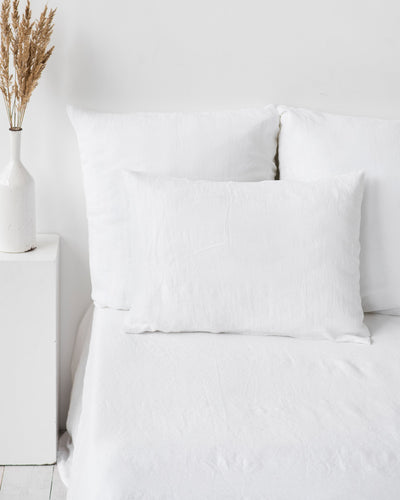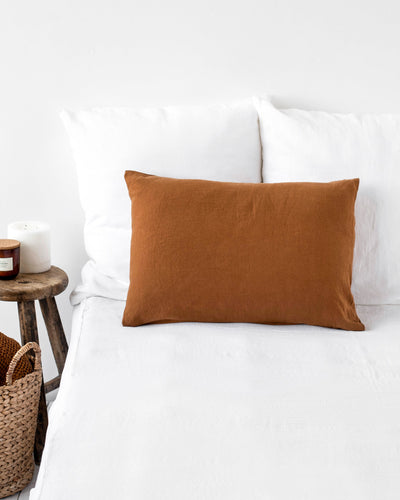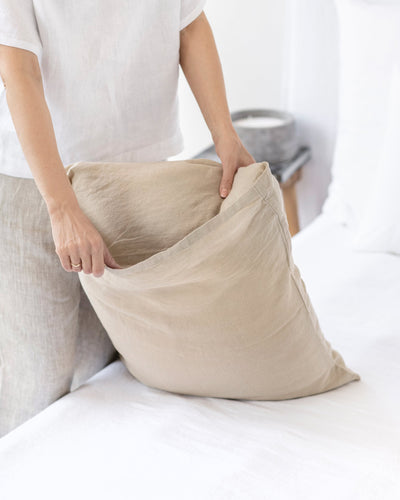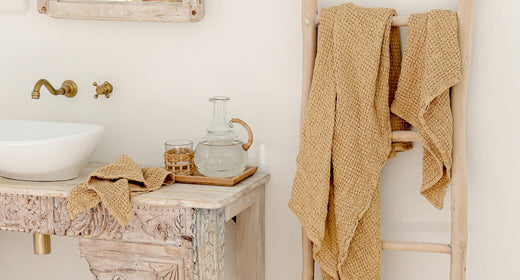How to Wash Linen for a Softer and Long-Lasting Fabric
Let’s start by saying that caring for linen items is simple and straightforward — high-quality linen fabric is sturdy and durable, so you won’t have to slave away tending to its whims. However, if you don’t know how to wash linen and want to make the most of your items, here are some basic rules you should follow.
Understanding Linen Fabric
Linen is a fabric known for its elegance and breathable qualities and has been used for centuries in garments, home textiles, and more. Its texture and versatility make it a favorite for everything from airy summer clothing to luxurious bedding.
However, linen also requires special care to remain in top condition. This fabric is more delicate than synthetic options and can degrade if mishandled. That’s why you must learn how to wash linen fabric properly to preserve its quality and enjoy its timeless charm.
Common types of linen items
Linen is used to craft various items suited to different needs and purposes. One of the most common uses is in bedding, including:
- sheets,
- pillowcases, and
- duvet covers.
Linen bedding is highly wanted because it regulates temperature, offering comfort in warm and cool climates.
Another popular use is linen clothing, such as:
- dresses,
- shirts, and
- trousers.
These garments are lightweight and breathable, making them ideal for summer.
In addition to bedding and clothing, linen is widely used in tableware like:
- tablecloths,
- placemats, and
- napkins.
While being informed about linen types is necessary for caring for such items, you should know that each type of linen product has its own care requirements. Understanding their specific nuances is crucial for keeping them in pristine condition.
PREPARATION BEFORE WASHING LINEN
Linen is a natural fiber and responds differently to cleaning processes than synthetic fabrics, so taking the time to prepare can prevent damage.
Here are some tips that many find helpful:
Check the care label
Every linen item comes with a care label. Keep in mind that this small piece of information is your best guide to proper washing. The label specifies whether the item should be hand-washed, machine-washed, or dry-cleaned. It also indicates the recommended water temperature and drying method.
Some linen products are pre-washed during manufacturing, making them softer and more tolerant of machine washing, while others may require extra care to avoid shrinkage or damage. Always start with these instructions to protect the fabric’s integrity.
Separate colors and whites
Another crucial preparation step is sorting linen by color. Linen, especially when new, can bleed dye during washing, potentially staining lighter fabrics. Separating dark and bright colors from whites ensures there’s no accidental discoloration.
Even natural-toned or undyed linen can absorb stray dyes, so washing similar shades together is wise.
Although this might seem like a very simple step, it helps preserve the original look of your linen pieces and prevents the hassle of fixing dye transfer mishaps.
Pre-treat stains
Stains on linen require quick attention to prevent them from setting into the fabric. Because linen is a natural fiber, it is highly absorbent, making it prone to soaking up spills quickly.
To effectively pre-treat stains, gently blot the area with a clean, dry cloth or paper towel as soon as the stain occurs. Avoid rubbing, as this can push the stain deeper into the fibers and damage the fabric’s texture.
Once you’ve blotted the stain, apply a gentle, stain-specific cleaner or a small amount of mild detergent directly to the affected area. For natural solutions, a mix of baking soda and water can work wonders on oil-based stains, while diluted vinegar can tackle organic stains like wine or coffee.
Allow the pre-treatment solution to sit for 5–10 minutes before washing. For stubborn stains, you can soak the item in lukewarm water with a mild detergent for up to 30 minutes, which helps loosen the stain without harsh scrubbing.
HOW TO WASH LINEN BY HAND AND MACHINE
After the necessary preparation, the fabric needs to be washed. Washing linen requires gentle handling to avoid damaging its delicate fibers.
Hand washing linen
Hand washing is often considered the safest option for delicate linen items. To start:
- Fill a basin with lukewarm water and add a small amount of mild detergent designed for delicate fabrics.
- Submerge the linen item and gently agitate the water to clean it.
- Avoid wringing or scrubbing the fabric, which can weaken its fibers and cause deformation.
- After a few minutes, drain the soapy water and rinse the linen thoroughly with clean water to remove any detergent residue.
- For heavily soiled items, repeat the process as needed.




And this is how to hand wash linen. But there’s more!
After rinsing:
- Press out the excess water by gently squeezing the fabric or pressing it against the basin’s side.
- Do not twist or wring the linen because it creates permanent wrinkles or damage.
- Lay the item on a clean towel and roll it up to absorb additional moisture before air drying.
Machine washing linen
Linen that is labeled machine-washable can be safely cleaned in a washing machine if handled carefully. Select a gentle or delicate cycle and use cold or lukewarm water to protect the fibers. Add a mild detergent free from harsh chemicals and avoid using bleach, which can cause discoloration and weaken the fabric. Avoid detergents that contain substances like Sodium Borate, Sodium Hydroxide, Cellulase, Protease, and Amylase. For smaller or more delicate linen items, consider placing them in a mesh laundry bag to minimize friction during the wash cycle.
Avoid overloading the washing machine, as linen needs space to move freely for thorough cleaning. Once the wash cycle is complete, remove the linen items promptly to reduce wrinkling. If you’re washing multiple pieces, give each one a gentle shake before drying to restore its natural shape.




How To Wash Different Linen Items?
While knowing whether your item belongs in the washing machine or not is a good starting point, there’s much more to properly caring for linen.
Each type of linen item, from bedding to clothing and tableware, has specific washing and handling requirements to maintain quality and longevity.
Here’s what you need to know:
Washing linen bedding
Linen bedding is luxurious and practical, so regular cleaning is essential to maintain its softness and cleanliness. Wash your linen sheets and duvet covers every one to two weeks, using cold or lukewarm water and a gentle detergent. Ensure your washing machine isn’t overloaded, as linen bedding requires plenty of space to move around for an even clean. Air drying is the best option for linen bedding, as it helps preserve its natural texture and prevents shrinkage.
To minimize wrinkles, remove bedding from the washing machine as soon as the cycle ends and give it a good shake before hanging to dry. If you prefer using a dryer, select a low-heat setting and remove the items while slightly damp. Finish by ironing or steaming for a crisp, smooth look, particularly for pillowcases or decorative bedding.
Caring for linen clothing
Linen clothing often faces everyday wear and tear, so careful washing is crucial. Hand washing is a far better choice for delicate or handmade items, but machine washing on a delicate cycle is usually safe for most garments. Use a mild detergent, and avoid fabric softeners, which can coat the fibers and reduce breathability.
After washing, gently reshape the damp clothing to retain its form, and air dry whenever possible.
For wrinkles, linen clothing can be ironed while slightly damp using medium to high heat. Alternatively, steaming works well for removing creases and refreshing the fabric without direct heat. Over time, linen clothing softens and becomes even more comfortable, making it a staple worth the effort.
Cleaning linen tablecloths and napkins
Linen tablecloths and napkins often endure spills, stains, and frequent use. Starts by pre-treating stains by applying a small amount of stain remover or mild detergent directly to the affected area. Allow it to sit for a few minutes before washing.
Wash tablecloths and napkins with similar colors on a delicate cycle using cold or lukewarm water. For heavily stained table linens, consider soaking them in warm water with a gentle detergent before laundering. Air drying is ideal for maintaining their structure, but they can also be tumble-dried on low heat. Iron these items while damp to achieve a smooth, polished finish perfect for your following meal setting.

How to Dry Linen Proprely
Now that you know how to wash linen in the washing machine or by hand, let’s teach you how to dry the fabric.
Drying is another critical step in caring for linen, as improper techniques can lead to shrinkage or stiffness. Here’s what you need to know:
Air-drying linen
Air drying is the gentlest and most recommended method for drying linen. Hang your items on a clothesline or drying rack, and evenly spread them out to avoid creasing. If drying indoors, choose a well-ventilated area to speed up the process and reduce the risk of mildew. Be cautious about prolonged exposure to direct sunlight, as it can cause fading, especially for darker or brightly colored linen.
When air drying, linen often develops wrinkles. To counteract this, smooth the fabric while it’s still damp. For larger items like bedding, you may need to rotate them occasionally to ensure they dry evenly.
Machine drying linen
While air drying is ideal, machine drying can be used for convenience if done carefully. Set your dryer to a low or no-heat setting and avoid overloading it. Remove the linen items while they’re still slightly damp to prevent over-drying, which can cause stiffness and make ironing more difficult. Shake out the items after removing them from the dryer to smooth any initial wrinkles before laying or hanging them to finish drying.
COMMON MISTAKES TO AVOID WHEN WASHING LINEN
Even with the best intentions, mistakes can happen when washing linen. Some of the most common errors include using harsh detergents or fabric softeners, which can coat the fibers and reduce their natural breathability. Always opt for mild, eco-friendly detergents designed for natural fabrics.
Another common mistake is washing or drying linen at high temperatures, which can cause shrinkage and weaken the fibers.
Overloading the washing machine or dryer is also problematic, as linen needs space to move freely for thorough cleaning and to prevent excessive wrinkling.
Lastly, skipping pre-treatment for stains can lead to permanent marks, especially with oil-based or colorful spills.
CONCLUSION
Linen is a beautiful, durable fabric that requires thoughtful care to maintain its unique qualities. Following the tips in this guide, you can keep your linen items looking and feeling their best for years. Each step, from proper washing techniques to careful drying methods, plays a role in preserving this timeless fabric.
The extra effort you invest in caring for linen will pay off in its softness, longevity, and enduring charm. Whether it’s your favorite linen dress, a luxurious linen sheet set, or an elegant tablecloth, linen deserves the care it needs to thrive.
FREQUENTLY ASKED QUESTIONS (FAQs)
Can I use bleach on linen?
No, bleach should never be used on linen, as it weakens the natural fibers and can cause discoloration. If you need to whiten or brighten linen, opt for an oxygen-based cleaner, which is gentler and safer for the fabric.
How often should I wash linen sheets?
Linen sheets should be washed every one to two weeks, depending on usage. Regular washing removes sweat, oils, and allergens while allowing the fabric to breathe and maintain its softness over time.
Does linen shrink when washed?
Linen can shrink slightly, especially if exposed to hot water or high heat in the dryer. To prevent shrinkage, always use cold or lukewarm water and low heat for drying. Pre-washed linen is less likely to shrink but still benefits from careful handling.
Can you use fabric softener on linen?
Fabric softener is not recommended for linen, as it can coat the fibers and reduce their natural absorbency and breathability. If you want to soften linen, use a vinegar rinse during the wash cycle or tumble dry on a low heat setting with dryer balls.
 United States
United States












